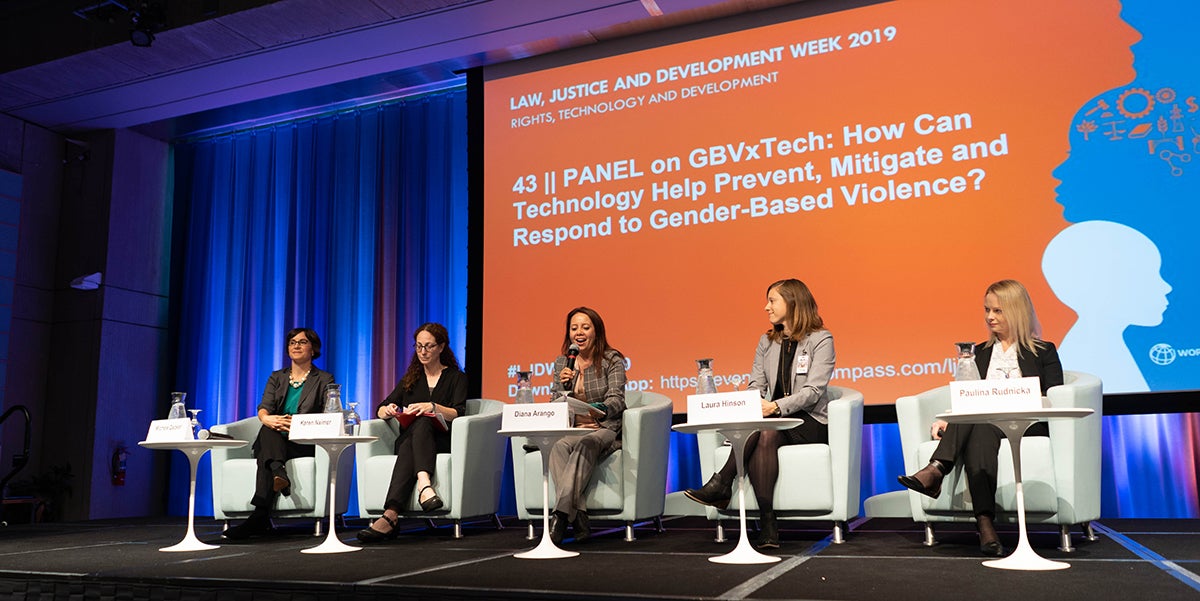 Panelists at the World Bank Group’s Law, Justice and Development week event on gender-based violence and technology. © Mirai Maruo/World Bank Group
Panelists at the World Bank Group’s Law, Justice and Development week event on gender-based violence and technology. © Mirai Maruo/World Bank Group
Technology provides new ways to prevent and respond to gender-based violence – but also new avenues for perpetrators. Researchers and legal experts gathered during the World Bank Group’s 2019 Law, Justice and Development week to explore the opportunities and risks.
Efforts are being made to use technology to improve women’s access to services as well as reduce the risk of sexual harassment. Technology is also helping to ensure easier and more comprehensive access to information and services, including for survivors of violence.
For example, MyPlan, a decision aid, is designed to help survivors of intimate partner violence navigate a safe way forward. US studies have found that safety aids help survivors feel more supported and confident when navigating decisions related to safety. Researchers at Johns Hopkins Bloomberg School of Public Health are adapting MyPlan for low and middle-income contexts including the Kyrgyz Republic.
And after years of field testing, Physicians for Human Rights has launched MediCapt, a mobile application that clinicians in Kenya and the Democratic Republic of the Congo can use to collect, document, and preserve forensic medical evidence to support prosecution of sexual violence crimes.
Both projects are supported in part by the Development Marketplace: innovations to address Gender-based violence, a partnership with the Sexual Violence Research Initiative to advance evidence-based, innovative research on preventing and responding to gender-based violence in low and middle-income settings.
The researchers and practitioners working on these apps emphasize:
- Technology is not a replacement for conventional approaches. It should reinforce existing mechanisms, and complement efforts to ensure appropriately trained professionals can support survivors.
- Tech-related solutions should be developed with end-users as equal partners, to ensure solutions are culturally-appropriate, relevant, and to achieve buy-in. This can be costly and time-consuming, but Physicians for Human Rights found the co-design process to be effective in building the skills of health and justice sector workers in addition to developing an effective application.
- Technology solutions require continuous investment and maintenance, which is often overlooked. Partner institutions need to be well-informed of the needs, to keep technology solutions relevant and sustainable. In working with municipal governments, Physicians for Human Rights ensures that running costs are budgeted for the upcoming year.
- The gender digital divide can’t be ignored: Gaps between men and women in digital literacy, affordability of devices, and access to hardware can reduce survivors’ ability to use services.
- Finally, ensuring that survivors can be referred to a comprehensive network of survivor-centered support services, regardless of the kind of technology being developed, and building the support ecosystem are critical.
While the opportunities are promising, technology also creates new risks. Perpetrators can use technology to monitor, harass, threaten, intimidate, impersonate, and stalk victims.
While known by a range of names, including online violence, cyber violence, online violence against women to name a few, the International Center for Research on Women has developed a comprehensive definition of “technology-facilitated gender-based violence”—an action using the Internet and/or mobile technology that harms someone because of their sexual or gender identity.
This framework aims to capture the full spectrum of behaviors and tactics involved and makes it clear that this form of violence often spills over into the real-world often with serious consequences.
Researchers trying to measure the prevalence of technology-facilitated violence have concentrated primarily on high-income settings. However, the American Bar Association has partnered with RIWI to undertake a study focused on low and middle-income settings.
The survey, covering 40,000 respondents in 15 countries, finds that nearly 40 percent of respondents do not feel safe from violence or harassment while online. Strangers were the most common perpetrators of violence.
Like other forms of gender-based violence, technology facilitated violence can have pervasive and insidious effects. More than 85% of respondents who had experienced online violence reported some form of real-world impact, from fearing for their safety to feeling anxious or depressed.
Gender-based violence is a global pandemic, and a multifaceted problem that cannot effectively be addressed from a single vantage point. Technology offers new tools for the development sector, researchers and practitioners to prevent and respond to violence, but we need to be careful to integrate these into our knowledge of what works, and use these tools with care.




Join the Conversation